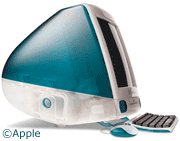It was just two years ago that people were first able to buy iMacs.
Some stores opened at midnight on August 15, 1998 so fans could buy
the Bondi blue marvel -
as early as Apple would allow them to sell the iMac.
 A lot has changed since then. Computers are
no longer drab beige boxes, and iMacs are no longer Bondi blue - or
even fruit flavored. Following the iMac's lead, all Macs are
non-beige.
A lot has changed since then. Computers are
no longer drab beige boxes, and iMacs are no longer Bondi blue - or
even fruit flavored. Following the iMac's lead, all Macs are
non-beige.
When the iMac was first announced in May 1998, Mac users pretty much
fell in love with the design. We complained about the 33.6 modem; Jobs
relented and gave us a 56k modem by the time the iMac shipped.
There were two radical things about the iMac: no legacy ports (ADB,
SCSI, Mac serial) and the new USB port that hadn't gone anywhere in the
Wintel world. That's right, USB was a Wintel invention, but it took
Apple to bring USB to prominence.
The original iMac came with 32 MB of memory, a 4 GB hard drive, a
24x CD-ROM, and a 233 MHz processor. Moore's Law predicts that will
double in 18-24 months. Today iMacs have 64-128 MB of memory, 7.5 to 30
GB hard drives, CD-ROM or DVD, and 350-500 MHz processors. Very
nice.
The Wintel world couldn't believe it, but the iMac became the best
selling computer model month after month in 1998. Before you knew it,
the PC makers were designing all-in-one computers far less attractive
than the iMac and recolored beige boxes. Ho hum.
But the best development of all is the iMac's value. While cheap
Wintel boxes have dropped as low as US$400 before edging upward
(monitor extra, of course, and usually including a $400 ISP rebate),
the iMac has dropped from $1,299 to $799 for the base unit with no
compromise in quality. And it finally includes a great mouse and a
decent extended keyboard.
The iMac has redefined the industry and redefined Apple as a
trendsetter. Just imagine where we'll be two years from now.

 A lot has changed since then. Computers are
no longer drab beige boxes, and iMacs are no longer Bondi blue - or
even fruit flavored. Following the iMac's lead, all Macs are
non-beige.
A lot has changed since then. Computers are
no longer drab beige boxes, and iMacs are no longer Bondi blue - or
even fruit flavored. Following the iMac's lead, all Macs are
non-beige.
